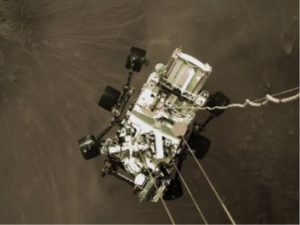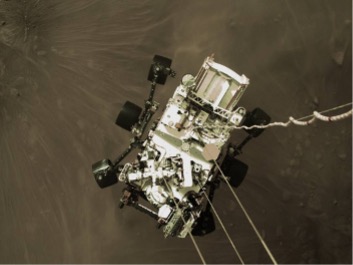By Joleen Traynor
Launched on July 30, 2020 and touching down on the surface of Mars on February 18, 2021, NASA’s Perseverance Rover reaches its destination.[1] The purpose of this rover’s mission is to “[s]eek signs of ancient life and collect samples of rock and regolith (broken rock and soil) for possible return to Earth.”[2] This is the first time since the 1970’s that a NASA mission has specifically searched for signs of life on Mars.[3] The rover will collect rock samples that will eventually be brought back to Earth for testing.[4] In addition to geological samples, the atmosphere on Mars will also be tested, to gather information for eventual future trips to Mars, including missions potentially carrying astronauts.[5]
Cameras on the rover were able to capture images of the rover in midair just before landing on the planet, where it landed in Jezero Crater.[6] In order to land in the Jezero Crater, the Perseverance Rover entered the atmosphere of Mars at 12,000 miles per hour, and it was aided by a parachute in order to make a safe landing.[7] This region of the planet was chosen for landing because it was believed that this area used to be a river delta, and that this crater was filled with water many years ago.[8]
The Perseverance rover is the largest vehicle NASA has ever attempted to land on Mars, coming in at a whopping weight of over a metric ton.[9] This is due, in part, to the added technology that has been included with the rover, featuring a number of new technological innovations that were unavailable for other rovers in past missions.[10]
The rover has travelled 300 million miles to reach the surface of Mars.[11] It takes 11 minutes for messages to be sent and received between the rover and Earth.[12] The rover is equipped with cameras to be able to capture images and video of the planet’s surface.[13] This mission opens up a whole new world of science and exploration on a distant planet. This is a scientific feat that has only scratched the surface of the knowledge and understanding scientists hope to be able to gain through this mission. The lifespan of this mission is intended to last one Martian year, which is 687 Earth days.[14] You can check out the images the Perseverance rover has already sent back to Earth here: https://www.nasa.gov/perseverance/images.
[1] NASA Science Mars 2020 Mission Perseverance Rover, https://mars.nasa.gov/mars2020/ (last visited Feb. 20, 2021).
[2] Id.
[3] Paul Rincon, Nasa Mars rover: Key questions about Perseverance, BBC (Feb. 19, 2021), https://www.bbc.com/news/science-environment-53129281.
[4] Id.
[5] Id.
[6] Ashley Strickland, Incredible new images shared by Perseverance rover after Mars landing, CNN World (Feb. 19, 2021, 4:00 PM), https://www.cnn.com/2021/02/19/world/mars-rover-new-images-scn-trnd/index.html.
[7] Sophie Lewis, How NASA’s Mars Perseverance rover will make the most difficult landing ever attempted on the red planet, CBS News (Feb. 18, 2021, 7:25 PM), https://www.cbsnews.com/news/mars-landing-nasa-perseverance-rover/.
[8] Id.
[9] Id.
[10] Id.
[11] Morgan McFall-Johnsen, NASA’s Perseverance rover is about to attempt a supersonic plunge to Mars, complete with a jetpack landing, Business Insider (Feb. 17, 2021 1:48 PM), https://www.businessinsider.com/how-nasa-perseverance-rover-will-land-on-mars-2021-2.
[12] Id.
[13] See NASA Science Mars 2020 Mission Perseverance Rover, https://mars.nasa.gov/mars2020/ (last visited Feb. 20, 2021).
[14] Mars 2020 Rover Depot Caching Strategy, https://mars.nasa.gov/mars2020/timeline/surface-operations/ (last visited Feb. 20, 2021).

Image Source: https://www.nasa.gov/image-feature/perservence-gets-ready-to-touch-down.
